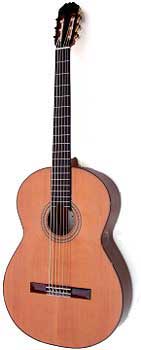The problem
The contrabass guitar is an octave below the classical guitar in pitch, and so the wavelength of the notes it produces are twice as long as on a classical guitar. In fact its bottom four strings are the same pitch as the orchestral double bass.
The contrabass body is nowhere near the size of a double bass, and it doesn't have anything like the same volume or depth. Indeed the contrabass is only about 11% larger than the classical guitar - see the relative dimensions here.
Classical guitars have a fundamental resonance close to G# on the bottom string.
In an ideal world, the contrabass would have its resonance exactly an octave below. In reality,
it can't do justice to the long wavelength notes because it's not large enough.
Instead, the resonance is only two tones lower, and it honks a bit too.
 |
 |
| Guitar resonance (about 110Hz) |
Contrabass resonance (about 80Hz) |
This lower resonance and thicker strings give the contra considerable extra warmth in the part of its register that overlaps the classical guitar, but below the resonance - the whole bottom octave - the sound is thin. The resonance is a particular nuisance as it excites the bottom string to leap into life in sympathy, with considerable power, each time one goes near it.
A solution
In these pages we tell you how we've modified hago's contrabasses to lower the resonance to somewhere between B and C, giving a tubbier bass.
 |
 |
| Before - 80 Hz | After - 64Hz |
And it's not a one-way ticket either - the modification can be undone in seconds, without leaving a mark!
Interested? Read on!
Click to read...
- Some theory (optional!)
- Making and fitting the insert
- A before and after comparison - listen for yourself!
- A before and after comparison on one of our bass guitars - listen for yourself!

The contrabass guitar